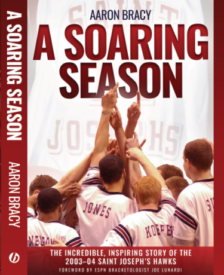
Drexel's players and staff gather before the start of the second half of Thursday's 86-66 win over William & Mary. (Photo: Aaron Bracy)
By AARON BRACY
February 6, 2025
PHILADELPHIA – We are living in the age of analytics. In all sports, not just basketball.
On the hardwood, you hear about the value in launching three-pointers early and often. In getting shots up quickly. In playing fast. In shots early in the shot clock. We are inundated with information overload, peppered with words and phrases like “offensive efficiency” and “points per possession.”

KenPom is a bigger name in college basketball, arguably, than any player in the sport. Think about it: Everyone who follows college hoops knows KenPom, but how many can name five players from even Top 25 teams?
Listen, there’s nothing wrong with analytics. They are important. Data helps understand performance, predict success, prevent failure. But an overreliance on data, an overreliance on numbers, an overreliance on analytics, as we are experiencing today in college basketball and sports, in general, is not healthy, not fun, and not good for the games.
Pressed by another reporter after Thursday’s impressive win over William & Mary at the DAC about defining his style of play, whether he wanted to play faster or whatever, coach Zach Spiker simply said, “We’re trying to play winning basketball.”
Isn’t that what it’s all about? Sometimes we get too deep into numbers and statistics and data to remember that there’s really only one number that matters: Did your team have more points than your opponent?
That’s all that mattered for the Spiker and the Dragons on Thursday night, analytics be damned.
Analytics wouldn’t suggest taking shots late in the shot clock.
But not only did the Dragons do that against W&M, but they planned to do it beforehand. Spiker figured the best way to slow down the Tribe’s high-octane, up-tempo, three-point launching (analytics, analytics, analytics!) attack was to milk the shot clock for all it’s worth on each possession. The Dragons moved the ball patiently and beautifully, not settling for a good look but finding the player with the best look. Sometimes it took until there was just a second or two left on the shot clock for the best look.
Most of the time, those good looks resulted in a make, as Drexel finished shooting 58.5 percent from the field.
It was one of the best-played games I’ve seen this season, if not the best, in terms of execution. The Dragons played with poise, composure, and skill. They shared the ball beautifully. If there was one bad shot taken, I didn’t see it.
Point guard Jason Drake, the Detroit native and JuCO transfer, was brilliant, finishing with 25 points, nine assists, four rebounds, and just one turnover in nearly 33 minutes of work. During one phenomenal second-half stretch, Drake scored 10 consecutive points.
“I was just having fun,” Drake said.
The Dragons, picked 11th of 14 teams in the Coastal Athletic Association in the preseason, inched up the crowded CAA standings. It is a tough league, a competitive one, with teams playing different styles, including the frenetic paces of squads like W&M, which entered third in the CAA and lost for just the third time in 11 league games.
Drexel’s style, if you had to put your finger on it, is just about winning, sharing the ball, playing smart, playing with poise, playing together.
The sign that hangs in the Drexel locker room epitomizes this, saying, “Sometimes You, Sometimes Me, Always Us.”
“We have a locker room of dudes that believe in that,” Spiker said.
The Dragons got contributions from up and down their lineup against the Tribe. In addition to Drake, Yame Butler (18 points), Villiam Garcia Adsten (13 points), and Kobe MaGee (10 points) also reached double-figures in scoring, with Butler and MaGee doing so while tip-toeing on three fouls early in the second half.
Others, like Victor Panov, Cole Hargrove, Shane Blakeney, and Kevon Vanderhorst, did lots of little things that add up to winning, setting screens, rebounding, helping on defense. Yeah, defense. It seems that analytics doesn’t love defense from much of what I’ve seen these days. The idea of defense, seemingly in the analytics age, is that we’ll let you score a quick two-pointer and then we’ll answer with a quick three-pointer.
Not at Drexel. As on offense, where I don’t think there was a single bad shot, I don’t think the Dragons took a single possession off defensively. If they did, I missed it. The Tribe earned every single one of their points.
It was beautiful and refreshing to watch. Spiker and the Dragons proved you don’t need to put up a million three-pointers. They did make 12 of 24 from deep, but it never felt like there were too many shots from the arc.
It was a throwback kind of a game, hearkening back to a day, oh not-so-long-ago, when the sport wasn’t cluttered up with metrics and data, when you played a style that was most appropriate to winning that game, when the most important number was just the one that was greatest on the scoreboard.
Kind of like this:
Drexel 86, William & Mary 66.
That’s easy enough to analyze. Yeah. Eighty-six is greater than sixty-six. Pretty simple. Yet, today, it seems so hard to understand.
—
Aaron Bracy has been covering Philadelphia sports since 1996. Follow Bracy on X: @Aaron_Bracy and like his Facebook and Instagram pages. His book on the 2003-04 Saint Joseph’s men’s basketball team is expected to be published on March 1, 2025. Read a summary and preorder it by clicking HERE. Contact him at aaron@big5hoops.com.